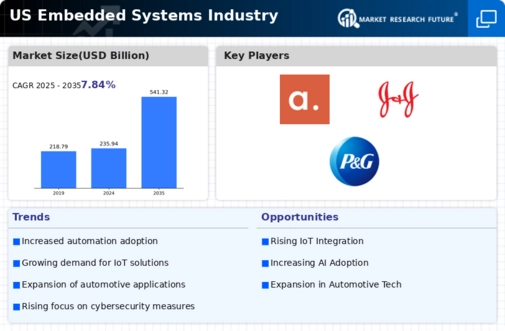Increased Focus on Automation
The trend towards automation across various industries is significantly impacting the embedded systems market. As businesses strive to improve efficiency and reduce operational costs, the integration of embedded systems in manufacturing, logistics, and other sectors is becoming more prevalent. In the US, the automation market is expected to grow by approximately 25% over the next five years, which will likely drive demand for embedded systems that facilitate automation processes. This shift suggests that companies will increasingly rely on embedded systems to enhance productivity and streamline operations, thereby creating new opportunities for growth within the embedded systems market.
Rising Demand for IoT Devices
The increasing proliferation of Internet of Things (IoT) devices is a primary driver for the embedded systems market. As more devices become interconnected, the need for efficient embedded systems that can handle data processing and communication grows. In the US, the IoT market is projected to reach approximately $1 trillion by 2026, indicating a robust demand for embedded systems that support these devices. This trend is likely to spur innovation and investment in the embedded systems market, as companies seek to develop solutions that enhance connectivity and functionality. Furthermore, the integration of embedded systems in various sectors, including healthcare, automotive, and smart homes, suggests a diverse range of applications that could further propel market growth.
Growth in Consumer Electronics
The consumer electronics sector is a significant contributor to the embedded systems market. With the continuous introduction of smart devices, such as smartphones, tablets, and wearables, the demand for embedded systems that provide enhanced functionality and performance is on the rise. In the US, the consumer electronics market is projected to reach $400 billion by 2026, with embedded systems being integral to the development of these products. This growth indicates a strong market for embedded systems, as manufacturers seek to create devices that are not only user-friendly but also capable of supporting advanced features like voice recognition and artificial intelligence. The embedded systems market is thus positioned to benefit from this consumer trend.
Emerging Applications in Healthcare
The healthcare industry is increasingly adopting embedded systems to improve patient care and operational efficiency. With the rise of telemedicine, wearable health devices, and remote monitoring systems, the embedded systems market is poised for growth. In the US, the healthcare technology market is projected to reach $500 billion by 2027, with embedded systems playing a vital role in the development of innovative medical devices. This trend indicates a growing reliance on embedded systems to support advanced healthcare solutions, such as real-time data analysis and patient monitoring. As healthcare providers seek to enhance service delivery, the embedded systems market is likely to experience significant expansion.
Advancements in Automotive Technology
The automotive sector is undergoing a significant transformation, with embedded systems playing a crucial role in this evolution. The shift towards electric vehicles (EVs) and autonomous driving technologies necessitates sophisticated embedded systems for vehicle control, navigation, and safety features. In the US, the automotive embedded systems market is expected to grow at a CAGR of around 10% from 2025 to 2030. This growth is driven by the increasing complexity of vehicle systems and the demand for enhanced user experiences. As manufacturers invest in advanced driver-assistance systems (ADAS) and connected car technologies, the embedded systems market is likely to see substantial advancements and opportunities for innovation.













Leave a Comment